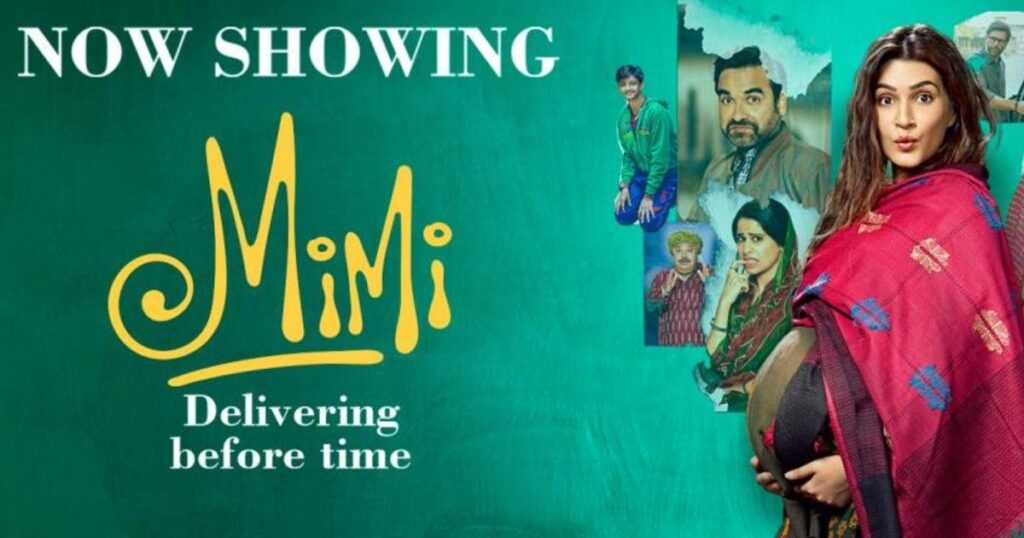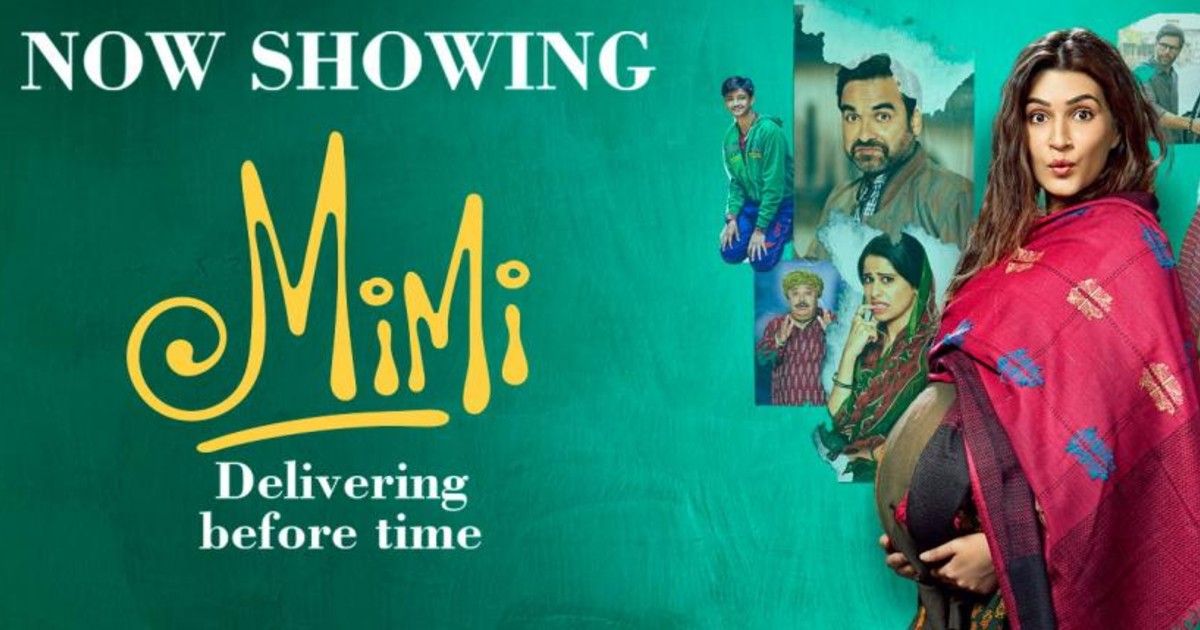
Mimi (2021, dir. Laxman Utekar) is not the first remake of the 2011 Marathi feature film Mala Aai Vhhaychy! (“I want to be a mother”), directed by Samruoddhi Porey. In 2013, a Telugu remake by director Singeetam Srinivasa Rao was released under the title Welcome Obama. Single persons, same-sex and unmarried couples from abroad had already been excluded from legal access to surrogacy in India before the complete ban of commercial surrogacy in 2016. This may partly explain why in the Hindi remake Mimi, it is not a single woman from the United States who commissions the surrogacy, unlike in the Marathi original. Rather, it is now an involuntarily childless married couple who are nevertheless conveniently able to contribute the necessary gametes themselves – sperms, egg cell – on site so that the fertilized egg can then be transferred to Mimi’s uterus in a specialized clinic in Jaipur. Mimi had never planned on becoming a gestational mother but the experience of becoming a mother will change her life forever.
The term gestational mother was created to refer to her supposedly limited role and neatly defined share of the now ‘split motherhood’, that is the carrying to term of the intended child. As many ethnographic studies and sensitive documentaries have clearly shown, it takes the gestational mother a lot of hard work – emotional and physical – to have and nurture a child in her womb that she must never think of as ‘belonging’ to her but to another family. Besides the surrogate or gestational mother, the other two ‘peripheral’ figures of this constellation conceivable today for the creation of children with the aid of assisted reproductive technologies (ARTs) are the sperm donor (unforgettably visualized in the figure of Vicky Arora in the hit film Vicky Donor, 2012) and the (still cinematically hardly represented figure) of the egg donor.
Proponents of gestational surrogacy argue for the bodily autonomy of the gestational mother and support the opportunity for the intended parents to end their unwanted childlessness and to gain access to the heteronormative family model through a (at least partly) genetically related child. The camp of proponents, however, is divided into those who are of the opinion that with strict legal regulation and good medical care, women should in principle have the option of being a gestational mother and that this work should be adequately remunerated; others, on the other hand, find it difficult to accept that a woman’s pregnancy and motherhood, which for a long time was hardly regarded as ‘work’, can be motivated other than just ‘altruistically’ and should accordingly be a free gift to the ‘other’ mother.
The young, unmarried Mimi Rathore from Rajasthan is anything but an ‘altruistic surrogate’, who has officially only been allowed in India since the Surrogacy (Regulation) Bill 2016 and 2019, nor is she a married women who already has children which were additional requirements for surrogates post-2016. Mimi works as a dancer in local Bollywood-inspired shows and dreams of a big film career in Mumbai for which she needs a seed capital. She is also not a ‘close relative’ of the commissioning couple, John and Summer, who are neither NRIs nor Indian citizens – and these are two more reasons why all three of them would currently not be legally allowed to enter into such an arrangement in India. This may have been one of the reasons the film’s plot was dated back to 2013.
The film, which is dedicated to ‘all mothers and motherhood’, avoids addressing current debates and problems that go far beyond the question of the non / permissibility of surrogacy and rather concern the question of what family is in today’s India, who has socially recognized access to this life model and who is excluded from it – including the self-chosen possibility of having children – or not. Is family defined only on the basis of the heterosexual married couple and (blood) relationship between parents and children, or is it possible to extend existing family models and to include, for instance, alternative or self-chosen families whose members take on caring relationships over a longer period of time?
As in the two previous versions, the question of motherhood is also at the center of the Hindi remake Mimi and the main character goes through a considerable maturation process, at the end of which the accidental gestational mother has indeed become an ‘altruistic mother’. Not only because, despite suspicion of Down’s syndrome, she gave birth to a child who is not genetically related to her and that the commissioning parents no longer wanted because it was not the ‘perfect product’ that they were expecting in return for their costly investment and extensive search for a physically fit surrogate. But because Mimi is a loving mother to the little, blond, blue-eyed, and thoroughly healthy Raj and is so absorbed in her newly found mother role that she gives up any ambition for a film career or an independently organized life as a woman. Her altruism even goes so far as to want to give up the beloved son and leave him to John and Summer, who suddenly appear after four years and pressure Mimi to hand the child over to them, in order to spare Raj the strains of a long legal process with an uncertain outcome.
The coincidence that prevents this at the last second for Mimi and her loved ones, who are also very attached to Raj, consists solely in the fact that John and Summer discover a girl in an orphanage that they want to adopt and take with them to the USA. In the end, they finally arrive at the point where they abandon their fixation on genetically related offspring and learn to perceive parenthood as independent of it. There is a reference in the end credits to the many children in orphanages in India who need parents and who intending parents should pay attention to instead of focusing on the idea of genetically related offspring with the help of assisted reproduction technologies and gestational mothers.
In view of the latest Surrogacy (Regulation) Bill 2020, which now allows ‘any willing woman’ to be an altruistic gestational mother, the admonishing index finger can hardly be overlooked: Forget it, you are underestimating what it means to become or to be a mother – you will not want to give away the child that you have and nurture in your womb for nine months and that you give birth to without great pain and sense of loss, even if it is not genetically related to you. Unfortunately, the very interesting approaches of the film, to think and stage family and living together ‘differently’, namely as a well-functioning elective affinity, which enables a harmonious and fulfilling togetherness regardless of the religious affiliation, class or caste background of its members, almost fades to the background vis-à-vis the strong focus on woman’s seemingly ‘natural’ desire and destiny to be a mother.
It was only in December 2021 that Netflix announced that it would lower the prices for streaming services in India to become more attractive to a non-elitist audience. In addition, the company announced that its program for the Indian market is to be ‘diversified’. Perhaps this will also enable new productions that dare to tell more stories about the questions and problems that actually concern many people in India today.
***
Nadja-Christina Schneider is currently professor of Gender and Media Studies for the South Asian Region (GAMS) at Humboldt University Berlin. Among others, she has worked and published on the visual representation of surrogacy in India and transcultural mediation of knowledge on assisted reproductive technologies.

[…] Read the whole article on Doing Sociology: https://doingsociology.org/2022/01/05/becoming-an-altruistic-mother-mimi-now-streaming-on-netflix-an… […]
… [Trackback]
[…] Read More here: doingsociology.org/2022/01/05/becoming-an-altruistic-mother-mimi-now-streaming-on-netflix-and-jio-cinema-but-why-exactly-now-nadja-christina-schneider/ […]